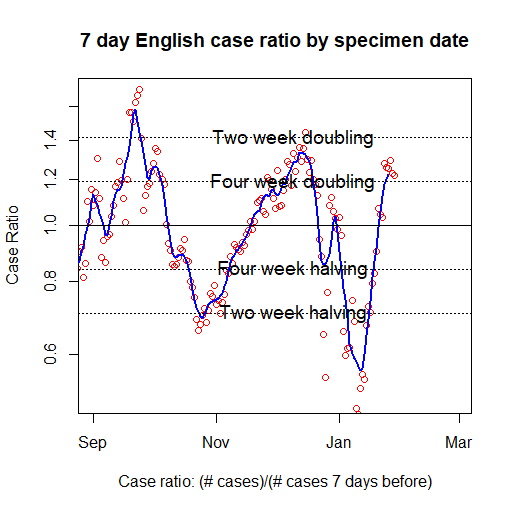(9am 2/2/23) This week, I wrote a piece about science communication for Substack and have been sharing book endorsements (Tim Harford, Ananyo Bhattacharya and Adam Kucharski so far, some more great ones to come!).
COVID-wise there was a general suspicion last week that things had bottomed out and were about to start rising again. To update on all this, the variant percentages have only changed a little bit - the XBB.1.5 variant that got people very excited at the start of the year is probably in the 10-12% range. It’s growing still, but not showing anything like the kind of competitive advantage that say BA.5 or BA.1 did.
On the other hand ZOE has incidence has shown a solid rise this week - from 105k to 139k, and the new data shows that admissions are now back rising again.
The growth rate is still establishing itself, but the most recent points suggest a 4 week doubling or so - so again, not as steep as previous waves, but admissions are still growing, and the growth rate itself (blue line) hasn’t settled down yet so this may accelerate somewhat further. (By eye it looks like an increase in hospital acquired admissions may be at least partly to blame, but I’ll leave it to Adele to crunch the numbers on that!)
(9.30am 2/2/23) As it is the first Thursday of the month, today is also the day for the latest Long COVID data from the ONS. The good news is that there is a modest drop in the number of people reporting the severest form of symptoms. (Note that there is a change of methodology at the point marked with the dotted line, so you can’t compare figures before and after).
Of course the number remains far too high, but in the context of ONS prevalence having been consistently in the millions for the last year (so probably at least 100,000 new cases per day) it’s reassuring news that these really high infection numbers haven’t converted over into a runaway increase in Long COVID cases as the naive Russian roulette model might have suggested.
(5pm 2/2/23) Cases also returning to growth, currently at about a “4 week doubling” kind of rate of increase.
(Midday 3/2/23) ONS is down again, though less steeply than the big drops in the previous two weeks. However, the latest level is not far off post-omicron lows. (Note this is week ending 24th January, so may not reflect the most recent position, so doesn’t contradict the recent rises in the graphs above).








